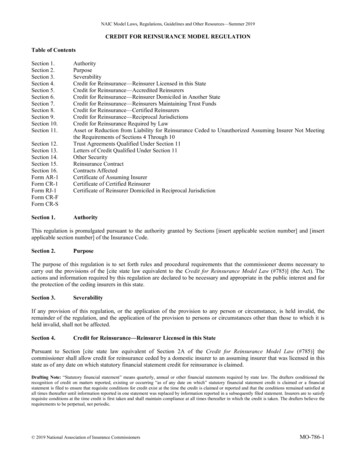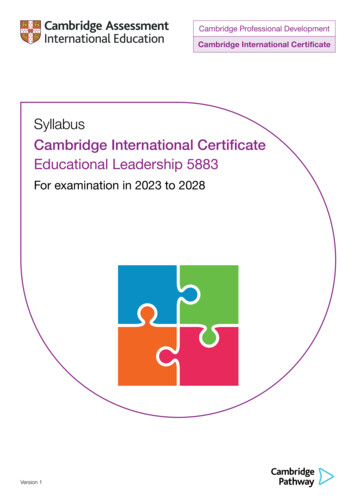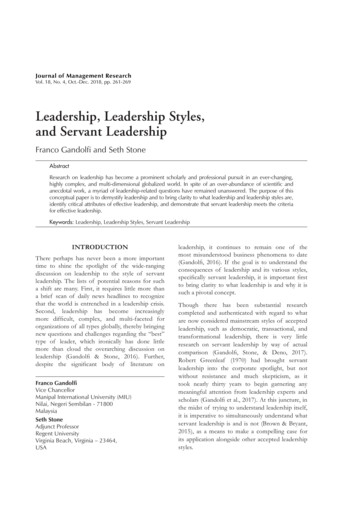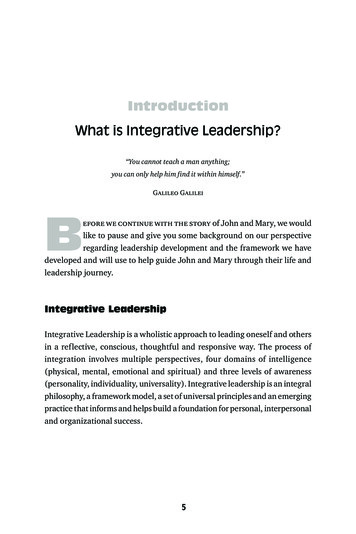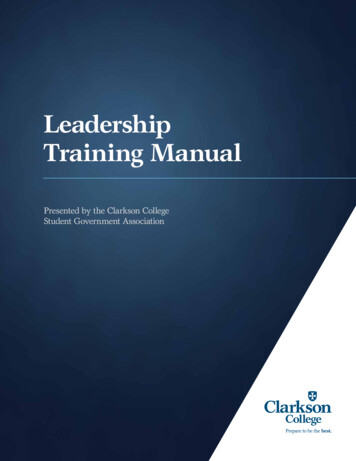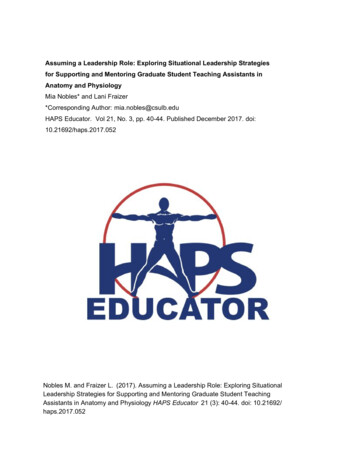
Transcription
Assuming a Leadership Role: Exploring Situational Leadership Strategiesfor Supporting and Mentoring Graduate Student Teaching Assistants inAnatomy and PhysiologyMia Nobles* and Lani Fraizer*Corresponding Author: mia.nobles@csulb.eduHAPS Educator. Vol 21, No. 3, pp. 40-44. Published December 2017. doi:10.21692/haps.2017.052Nobles M. and Fraizer L. (2017). Assuming a Leadership Role: Exploring SituationalLeadership Strategies for Supporting and Mentoring Graduate Student TeachingAssistants in Anatomy and Physiology HAPS Educator 21 (3): 40-44. doi: 10.21692/haps.2017.052
Assuming a Leadership Role: Exploring Situational LeadershipStrategies for Supporting and Mentoring Graduate StudentTeaching Assistants in Anatomy and PhysiologyMia Nobles MS1 and Lani Fraizer EdD21Department of Biology, College of Natural Sciences, California State University Long Beach, 1250 Bellflower Blvd, Long Beach, CA908402Graduate School of Education and Psychology, Pepperdine University, 6100 Center Drive, Los Angesles, CA 90045mia.nobles@csulb.edu, lani.fraizer@pepperdine.eduAbstractAlthough literature posits the invaluable role of educators as both teachers and leaders in cultivating meaningful student learningexperiences, many educators do not identify themselves as leaders (Barth, 2001). This paper explores leadership strategies forcultivating teacher-leader identity in Anatomy and Physiology educators. Due to large student enrollment numbers, faculty mustoften rely on student teaching assistants (TAs) to deliver the laboratory portion of their course. As teacher-leaders, faculty canassume leadership roles as both mentors and resource providers to course TAs and create a course culture of purposeful and deeplearning. doi: 10.21692/haps.2017.052Key Words: leadership, anatomy, physiology, mentorship, meaningful learningIntroductionAs a foundational course for most health professions,instructors of undergraduate human Anatomy and Physiologyface the unique challenge of teaching an extensive amount ofcontent to a large body of diverse students. Students enroll tomeet general education science requirements, pre-requisiterequirements for professional programs, and foundationalmajor requirements in varied tracks including dance science,nursing, kinesiology, and the allied health sciences. Withsizeable enrollment numbers, an additional challenge liesin that faculty must often rely on graduate student teachingassistants (TAs) to deliver the laboratory portion of theircourses across a number of sections.Although there is no universal agreement on the mosteffective method of Anatomy and Physiology instruction,there is a general consensus that students must be ableto do more than accumulate facts. Educators well versedin modern learning theory have established the view thatlearning is more than memorization (Scott 2015) or acquiringknowledge (Mayer 2002). Learning is not a passive experienceand requires doing as much as it requires knowing (Schanket al. 1999). Building a culture of active learning at all levelsof instruction is critical to establishing meaningful learningexperiences. These experiences are essential for studentsto be able to transfer and apply foundational Anatomy andPhysiology principles to future upper division courses andprofessional programs. Culture can powerfully influencebehavior and because of its near invisibility, culture changesonly after actions have successfully been altered (Kotter1996). Intentionally anchoring a student-centered teachingphilosophy into the Anatomy and Physiology course cultureis important because it can powerfully influence the teachingpractices of TAs.It is well established in the literature of modern learningtheory that the shift from traditional instructionist methodsto meaningful active-learning experiences is where thefuture of education is headed, but how does the communityof Anatomy and Physiology educators diffuse this culture ofmeaningful active-learning to all levels of instruction and inparticular graduate student TAs? Although novel teachingstrategies is a familiar topic in Anatomy and Physiologyeducation literature, there is much less discussion abouthow to successfully disseminate these ideas to courseTAs. Teaching Assistants are responsible for teaching thelaboratory portion of the course where meaningful interactionis essential to the experience. Faculty must intentionallyconsider how to develop a course culture that encourages TAsto adopt practices that align with student-centered teachingphilosophies. This paper explores two different leadershipstrategies (situational approach and skills approach) forcultivating teacher-leader identity in Anatomy and physiologyeducators. As teacher-leaders, faculty can assume leadershiproles as both mentors and resource providers to course TAsand create a course culture of purposeful and deep learning.Teacher-Leader IdentityAlthough literature posits the invaluable role of educators asboth teacher and leader in cultivating meaningful studentlearning experiences (ASCD 2014, Lieberman and Friedrich2007), many educators do not identify themselves as leaders(Barth 2001). Although literature indicates that teachers asleaders mindset is increasingly garnering attention (ASCDcontinued on next page40 HAPS EducatorJournal of the Human Anatomy and Physiology SocietyDecember 2017 Winter Edition
Assuming a Leadership Role: Exploring Situational Leadership Strategies for Supporting and Mentoring Graduate Student Teaching Assistants in Anatomy and Physiology2014), Barth argues that “something deep and powerful withinschool cultures seems to work against teacher leadership”(p. 444) and that teacher-leaders rarely comprise of morethan a quarter of faculty. It is important for Anatomy andPhysiology faculty to recognize their leadership mindset andintentionally explore leadership techniques to successfullyassume leadership roles as mentors and resource providersto their course TAs. This mindset requires faculty to ‘“shifttheir paradigm” and to break with and replace their past waysof thinking and knowing with a totally new understandingof their role and its purpose (Bull and Gilbert 2012 p. 6). Asingle Anatomy and Physiology large lecture class can havefive or more laboratory sections attached to it and it is notuncommon for each section to be taught by a different TA.Situational Approach to LeadershipWith a group of TAs to provide support and mentorship to, it isimportant that faculty are adaptable in their leadership style.The situational approach to leadership (Hersey and Blanchard1969, Blanchard et al. 2013) takes the view that to be aneffective leader, one must adapt their leadership style to meetthe abilities and needs of their followers and characterizesleadership as having a directive and a supportive componentand that each must be applied to a certain degree dependingon the situation. Northouse (2016) writes:“To determine what is needed in a particular situation, a leadermust evaluate her or his followers and assess how competentand committed they are to perform a given goal. Based on theassumption that followers’ skills and motivation vary whichthey are directive or supportive to meet the changing needs offollowers” (p.93).Northouse (2016) defines directive behaviors as behaviors that“help group members accomplish goals by giving directions,establishing goals and methods of evaluation, settingtimelines, defining roles, and showing how the goals are to beachieved” (p.94) and defines supportive behaviors as behaviorsthat “help group members feel comfortable about themselves,coworkers, and the situation” (p.94).In applying this approach to Anatomy and Physiology facultyand their mentorship of course TAs, faculty must match theirlevel of direction and support to the level of competence andcommitment specific to each of their TA’s. Northouse (2016)summarizes how the SLII model organizes the degree offollower competence and commitment across a continuumwith four development level categories: D1 (low competence;high commitment), D2 (some competence; low commitment),D3 (moderate to high competence; variable commitment), andD4 (high competence; high commitment). For Anatomy andPhysiology faculty to be effective in their leadership roles asmentors and resource providers, they must recognize whereeach of their TAs fall along this developmental continuumand assign a specific leadership style to meet those needs.Leadership styles are organized in a similar manner todevelopmental level. Northouse (2016) summarizes how theSLII model organizes leadership styles into four categoriesof directive and supportive leadership behavior: S1 (directingstyle: high directive; low supportive), S2 (coaching approach:high directive; high supportive), S3 (supporting approach: lowdirective; high supportive), and S4 (delegating approach: lowdirective; low supportive); the appropriate leadership stylenumber corresponds to the determined development levelnumber.Situational Approach to Leadership: ApplicationTo successfully assume their leadership role as a mentor andresource provider to course TAs, faculty must ask themselvesthe following questions: What teaching practices are myTAs being asked to adopt? What type of course culture doI want to cultivate? Do my TAs have the experience andskills necessary to successfully facilitate active-learningexperiences? Where does teaching fall among my TAs’ list ofpriorities as a graduate student? Do they have the motivationand desire to make learning in their laboratories an authenticand meaningful learning experience? Answering thesequestions will help faculty identify the developmental level oftheir TAs and thus prescribe a leadership style approach.Situational Approach to Leadership: CaseStudiesThe following two case studies are examples of developmentallevel identification and the appropriate prescription ofleadership style on the D1-S1 and D4-S4 ends of the SLII model’s continuum:Case Study 1One of your TAs, Dru, is in his first semester of his first year asa graduate student in the biology department. His bachelor’sdegree is in microbiology and as a graduate student he isworking in a research laboratory that works primarily withdrosophila. He has no significant teaching experience apartfrom some microbiology tutoring that he completed anundergraduate student. Dru is your most inexperienced TA,but he is also the most enthusiastic. He constantly asks forfeedback regarding instructional technique and often comesto your lectures to observe your teaching methods.According to the SLII model, Dru’s lack of direct Anatomy andPhysiology teaching experience combined with his positiveattitude and openness to develop his teaching skills classifieshim overall as D1 on the development level continuum. Inaccordance with the SLII model, his faculty mentor wouldadopt the directing leadership style (S1) and spend themajority of their time helping Dru cultivate his active-teachingskills and discussing the Anatomy and Physiology laboratorycontent. Northouse (2016) asserts that this style of leadership“gives instructions about what and how goals are to beachieved by the followers and then supervises them carefully”(p.94).continued on next page41 HAPS EducatorJournal of the Human Anatomy and Physiology Society December 2017 Winter Edition
Assuming a Leadership Role: Exploring Situational Leadership Strategies for Supporting and Mentoring Graduate Student Teaching Assistants in Anatomy and PhysiologyCase Study 2One of your TAs, Christina, is in her third year as a graduatestudent in the biology department and works in the cadaverprosection lab on campus. As an undergraduate, shemajored in biology and served as an Anatomy and Physiologylaboratory peer mentor and Anatomy and Physiologysupplemental instruction leader. She already has one Master’sdegree in anatomical illustration and she spent two years asa TA for general Anatomy and Physiology courses during herprevious graduate program. Gross Anatomy and Physiology isher passion and she is both dedicated and enthusiastic aboutthe goal of fostering meaningful active-learning experiencesin the Anatomy and Physiology laboratory classroom.According to the SLII model, Christina’s high degree ofexperience and strong sense of commitment to teachingAnatomy and Physiology classifies her overall as D4 on thedevelopment level continuum. In accordance with theSLII model, her faculty mentor would adopt the delegatingleadership style (S4) and spend less time intervening, andinstead let Christina take responsibility for her laboratorysection. Northouse (2016) states that this style of leadership“offers less goal input and social support, facilitating followers’confidence and motivation in reference to the goal” (p.95).The functional and easily applied SLII model is especiallypractical due to its prescriptive value that supplies leaders witheasily understandable guidelines to effectively adapt theirleadership styles to a variety of situations (Northouse, 2016).The complete SLII model can be found at: https://www.kenblanchard.comSkills Approach to Leadership: 3-Skill ApproachRobert Katz (1955) addressed leadership as a set ofdevelopable skills rather than definitive traits, suggesting thatleadership skills and abilities can be acquired and that leaderscan be trained to develop them (versus traits that are innatebiological characteristics). Katz (1955) identified three basicadministrative skills that are essential to effective leadership.Northouse (2016) defines each skill:1. Technical Skill – Knowledge about and proficiencyin a specific type of work or activity. It includescompetencies in a specialized area, analytical ability,and the ability to use appropriate tools and techniques(p.44).2. Human Skill – Abilities that help a leader to workeffectively with followers, peers, and superiors toaccomplish the organization’s goals (p.45).3. Conceptual Skill – The ability to work with ideas andconcepts. Conceptual skills are central to creating avision (p.45).3-Skill Approach Application and ExamplesKatz (1955) concluded that all three of these skills areimportant to successful leadership, but some skills are moreimportant depending on the different levels of management(top, middle, and supervisory) of the individual. Facultymust report to department administrators on one end andmanage both graduate TAs and undergraduate studentson the other end; thus, faculty can be considered a middlelevel management category. According to Katz (1955) thismiddle level of management is the only level that puts anequally important emphasis on all three of the basic skills(technical, human, and conceptual). Thus, it would bebeneficial to approach leadership development in a mannerthat encourages faculty to reflect on their relationship to ofall three of these leadership skills in the context of the theirleadership role as a mentor and support provider to theircourse TAs.For example, Anatomy and Physiology faculty completingthis exercise might consider the application of Katz’s threeleadership skills in the following way:1. Technical Skill – Assess my own knowledge of learningtheory, Anatomy and Physiology subject mattercontent, laboratory procedures, and clinical application;reflect on my own ability to effectively engage inmeaningful and active-teaching methods.2. Human Skill – Acknowledge my own perspectives inregards to teaching and learning and, at the same time,be aware of the perspectives of my TAs.3. Conceptual Skill – Consider my ability to articulatemy vision (of creating a course culture that embracesmeaningful active-learning experiences) to my TAs.Skills Approach to Leadership: Skills-ModelAccording to Northouse (2016) Katz’s work in the 1950s setthe stage for the skills-model of leadership developed byMumford et al. (2000) that frames leadership by describingfive components of leader performance: competencies,individual attributes, career experiences, environmentalinfluences, and leadership outcomes. The competencies(problem-solving skills, social judgment skills, and knowledge) arecentral to the model and are the fundamental determinantsof leadership outcomes (effective problem solving andperformance) (Northouse, 2016). The competencies areinfluenced and impacted by individual attributes (cognitiveabilities, motivation, and personality), career experiences, andenvironmental influences (Northouse 2016).The skills-model by Mumford et al. (2000) is essentially a mapto reach effective leadership. Northouse (2016) predicts thatthe skills-model may be used in the future as a template todesign leadership professional development programs (PD).The skills-model provides a picture of how skills relate tocontinued on next page42 HAPS EducatorJournal of the Human Anatomy and Physiology Society December 2017 Winter Edition
Assuming a Leadership Role: Exploring Situational Leadership Strategies for Supporting and Mentoring Graduate Student Teaching Assistants in Anatomy and Physiologythe growth of effective leaders (Northouse 2016) and can beutilized in leadership PD to support and encourage teachersin understanding the factors that affect their leadershipcompetencies and ultimately leadership outcomes.Skills-Model Application and ExamplesFor example, after identifying one’s own leadershipcompetencies (problem-solving skills, social judgmentskills, and knowledge), Anatomy and Physiology facultyparticipating in a skills-model based leadership PD wouldconsider the impact of their own individual attributes,career experiences, and environmental influences on thosecompetencies. Individual attributes may include theirown level of openness to providing genuine mentorship totheir TAs or their personal level of motivation to restructuretheir course and facilitate more active-learning experiences.Faculty may reflect on the manner that their level of careerexperience influences their understanding of the perspectivesand attitudes that their course TAs have towards instructionalpractices and student learning in Anatomy and Physiology.Faculty may also consider how their experience impactstheir ability to adapt to meet their TAs’ needs. In recognizingthe impact of environmental influences on leadershipcompetencies, faculty may consider the influence of internalfactors such as communication with or initial expertise of TAs.The skills model establishes the importance of leaders havingproblem-solving skills, social judgment skills, and knowledgeto become an effective leader (Northouse 2016). Framingleadership in terms of skills makes leadership somethingthat can be learned or developed and essentially available toeveryone (Northouse 2016). Describing leadership as a set ofskills transforms it into a process that faculty can practice todevelop and cultivate their identity as a teacher-leader.ConclusionsThe importance of the role of graduate student TAs inundergraduate Anatomy and Physiology education has beenvery much overlooked in Anatomy and Physiology educationliterature. Modern learning theory has established that theshift from traditional instructionist methods to meaningfulactive-learning experiences is where the future of educationis headed. Considering that TAs deliver the laboratory portionof the course where meaningful interaction is essential tothe Anatomy and Physiology student learning experience, itis important for Anatomy and Physiology faculty to assumeleadership roles as mentors and resource providers to diffusethe culture of meaningful active-learning to their course TAs.The SLII model (situational approach to leadership) providesguidelines that allow faculty to identify the developmentallevel of each of their TAs and prescribes an effective leadershipstyle to meet each of their specific needs. The skills-model(skills approach to leadership) frames leadership in termsof learnable skills so that leadership is something that canbe developed and essentially available to everyone. Thismodel acts a map to reach effective leadership and can be43 HAPS Educatorutilized in leadership PD to support and encourage teachersin understanding the factors that affect their leadership. Bypurposefully exploring leadership strategies and techniques,Anatomy and Physiology faculty can assume effectiveleadership roles as mentors and resource providers to supporttheir course TAs and together build a course culture ofmeaningful active-learning experiences.Future considerations include the development,implementation, and testing of a leadership modelspecific to faculty looking to assume leadership roles inproviding support and mentorship to graduate student TAs.Furthermore, suggestions for future explorations includerole of emotional intelligence in leadership development.Goleman (2000) indicates that leaders relying on more thanone leadership style, depending on the needs of a situation,garner best results. The investigation of how TA background,experiences, practices, attitudes, and emotional intelligenceimpact the undergraduate student learning experience wouldbe invaluable in developing this leadership model and itssuccessful application in leadership PD.About the AuthorsMia Nobles is a Lecturer in the Department of BiologicalSciences at California State University Long Beach. Sheteaches undergraduate human anatomy and physiology. Miais completing her doctoral studies at Pepperdine University’sGraduate School of Education and Psychology in LearningTechnologies.Lani Fraizer is Associate Professor of Learning Technologiesand Chair of Extended Learning and Global Partnerships atthe Graduate School of Education at Pepperdine University,teaching at the cross-sector areas of global leadership, socialinnovation and technology. She is also a Visiting Scholar forNobel Laureate Muhammad Yunus at the Asian Institute ofTechnology in Pathumthani, Thailand.Literature citedASCD (2014) Teacher leadership: The what, why and how ofteachers as leaders. Retrieve from all2014wcsreport.pdfBarth RS (2001) Teacher Leader. Phi Delta Kappa International.pp.443-449.Blanchard K, Zigarmi P and Zigarmi D (2013) Leadership andthe one minute manager: Increasing effectiveness throughSituational Leadership II. New York: William Morrow.Bull A and Gilbert J (2012) Swimming Out of Our Depth: LeadingLearning in 21st Century Schools. Wellington, New ZealandCouncil for Educational Research. Retrieve from http://www.nzcer. org.nz/system/files/Swimming%20out%20of%20our%20 depth%20final.pdfJournal of the Human Anatomy and Physiology Societycontinued on next pageDecember 2017 Winter Edition
Assuming a Leadership Role: Exploring Situational Leadership Strategies for Supporting and Mentoring Graduate Student Teaching Assistants in Anatomy and PhysiologyGoleman D(2000) Leadership that gets results. HarvardBusiness Review. pp. 78-90.Hersey P and Blanchard KH (1969) Life-cycle thoery ofleadership. Training and Development Journal. 23: 26-34.Katz R (1955) Skills of an effective administrator. HarvardBuisness Review. 33(1): 33-42.Kotter JP (1996) Leading Change. Boston, MA: Harvard BusinessSchool Press.Lieberman A and Friedrich L (2007) Changing teaching fromwithin: Teachers as leaders. Presented at the AmericanEducational Research Association Annual Meeting,Chicago, IL: April 9-13.Mayer RE (2002) Rote Versus Meaningful Learning. Theory IntoPractice. 41(4): 226-232.Mumford M, Zaccaro SJ, Harding FD, Jacobs TO and FleishmanEA (2000) Leadership skills for a changing world: Solvingcomplex social problems. Leadership Quarterly. 11(1): 1135.Northouse RG (2016) Leadership Theory and Practice. ThousandOaks, CA: SAGE Publications.Schank RC (1999) Learning by Doing. In C. M. Reigeluth (Ed.),Instrutional-design theories and models: A new paradigmof instructional theory (Vol. II, pp. 161-181). Mahwah, NJ:Lawrence Erlbaum Associates.Scott CL (2015) The futures of learning: What kind of pedagogiesfor the 21st century? UNESCO Education Research andForesight, Paris. [ERF Working Papers Series, No. 15].Back to TOC44 HAPS EducatorJournal of the Human Anatomy and Physiology Society December 2017 Winter Edition
2Graduate School of Education and Psychology, Pepperdine University, 6100 Center Drive, Los Angesles, CA 90045 mia.nobles@csulb.edu, lani.fraizer@pepperdine.edu Abstract Although literature posits the invaluable role of educators as both teachers and leaders in cultivating meaningful student learning
